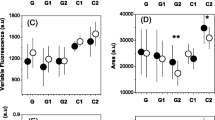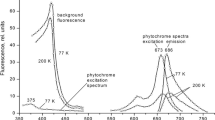Summary
Dry seeds of Amaranthus caudatus show little or no photoreversible absorption changes, attributable to phytochrome. During imbibition phytochrome appears in two phases, one immediately after sowing and the second after about 8 hr. Experiments at different temperatures and under continuous illumination with red, far-red and blue light suggest that there are two pools of phytochrome. The first phase in the appearance of phytochrome could be due to the change in optical properties of the sample on hydration or to rehydration of inactive phytochrome, or both. The second phase probably represents phytochrome synthesis. It is absent at 0° and precedes the water uptake associated with germination by some 10 hr. This second pool of phytochrome does not accumulate in red and blue illuminated seeds indicating that the rate of P fr decay is more rapid than the rate of phytochrome synthesis. The difference spectra of phytochrome in both 2 hr imbibed seeds and 72 hr old seedlings show peaks of absorption at 663 and 735 nm. The presence of P fr in dark imbibed seeds and the process of “inverse reversion” of P r to P fr in darkness have been demonstrated. The results are discussed in relation to previous hypotheses for the mechanism of photocontrol of Amaranthus seed germination.
Similar content being viewed by others
References
Boisard, J., C. J. P. Spruit, and P. Rollin: Phytochrome in seeds and an apparent dark reversion of P r to P fr. Meded. Landbouwhogeschool Wageningen 68, 17 (1968).
Clarkson, D. T., and W. S. Hillman: Stable concentrations of phytochrome in Pisum under continuous illumination with red light. Plant Physiol. 43, 88–92 (1968).
Hillman, W. S.: The physiology of phytochrome. Ann. Rev. Plant Physiol. 18, 301–324 (1967).
Kendrick, R. E., and B. Frankland: Kinetics of phytochrome decay in Amaranthus seedlings. Planta (Berl.) 82, 317–320 (1968).
——: Photocontrol of germination in Amaranthus caudatus. Planta (Berl.) 85, 326–339 (1969a).
——: The in vivo properties of Amaranthus phytochrome. Planta (Berl.) 86, 21–32 (1969b).
Lint, P. J. A. L. de, and C. J. P. Spruit: Phytochrome destruction following illumination of mesocotyls of Zea mays L. Meded. Landbouwhogeschool Wageningen 63, 14 (1963).
Mancinelli, A. L., and A. Tolkowsky: Phytochrome and seed germination. V. Changes in phytochrome content during germination of cucumber seeds. Plant Physiol. 43, 489–494 (1968).
Spruit, C. J. P.: Absorption spectrum changes during dark decay of phytochrome-730 in plants. Meded. Landbouwhogeschool Wageningen 65, 12 (1965).
Spruit, C. J. P., J. Boisard, and P. Rollin: Spectrophotometric phytochrome in seeds of dark grown plants. Plant Physiol. 43, S-15 (1968).
—, and A. L. Mancinelli: Phytochrome in cucumber seeds. Planta (Berl.) 88, 303–310 (1969).
Tobin, E. M., and W. R. Briggs: Phytochrome in embryos of Pinus palustris. Plant Physiol 44, 148–150 (1969).
Author information
Authors and Affiliations
Rights and permissions
About this article
Cite this article
Kendrick, R.E., Spruit, C.J.P. & Frankland, B. Phytochrome in seeds of Amaranthus caudatus . Planta 88, 293–302 (1969). https://doi.org/10.1007/BF00387457
Received:
Issue Date:
DOI: https://doi.org/10.1007/BF00387457




